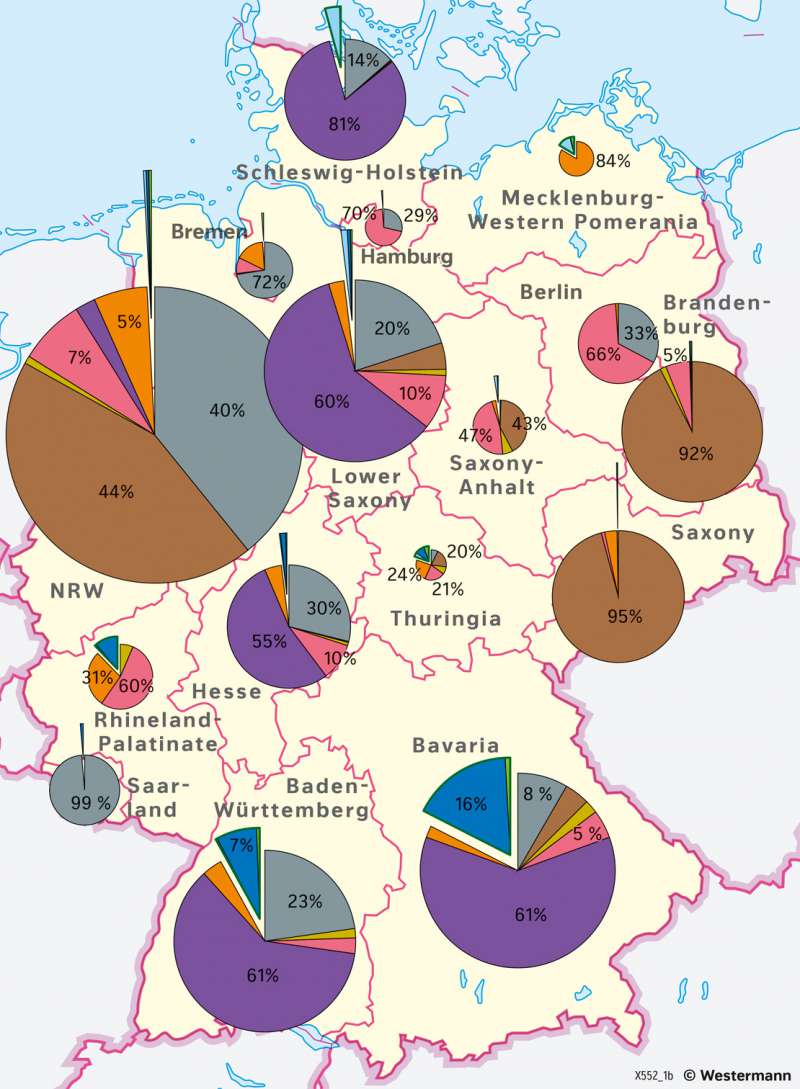Germany - The changing energy mix
Energy
978-3-14-100890-6 | Page 75 | Ill. 3

Overview
In recent decades, the electricity mix in Germany has changed significantly. According to a resolution of the Federal Government, greenhouse gas emissions were supposed to be reduced by 40 per cent by 2020 compared to 1990 and also further beyond 2020. This is only possible if coal-fired power plants, which have been the main source of generation, are partially shut down and renewable energy sources are expanded. Further gains in this sector are to be expected above all in the areas of wind power, biomass, and photovoltaics. A second important reason for changes in the electricity mix is the phasing out of nuclear energy, which began in 2000 under the initiated under the Red-Green government and adopted by the Bundestag in 2011. It is to be completed by the end of 2022.
Energy transition in Germany
In 2019, 30.3 per cent of all electricity was generated from coal. Thus, coal was still the most important source of energy. However, its importance is declining: In 1994, 54.0 per cent of electricity nationwide still came from lignite and hard coal. In five federal states (Saxony, North Rhine-Westphalia, Brandenburg, Bremen, Saarland), the share of coal was still above 60 per cent in 2019. Nuclear energy has lost even greater shares: In 1994, 28.7 per cent of gross electricity nationwide was generated from nuclear energy, by 2019 its share had fallen to 13.7 per cent. It had the largest share of the energy mix in Bavaria, followed by Baden-Württemberg, Schleswig-Holstein, and Lower-Saxony.
Renewable energies have experienced rapid growth, and their share is rising steadily. Whereas in 1994 just under 5 per cent of all electricity was generated from renewable energies, by 2019 this figure had risen to 40.5 per cent. The share in the energy mix in 2019 was higher in the eastern German states of Mecklenburg-Vorpommern and Thuringia as well as Schleswig-Holstein, followed by Saxony-Anhalt, Bavaria and Rhineland-Palatinate. The lowest shares were in North Rhine-Westphalia, Hamburg and Berlin. These shares reflect very different structures: while electricity generation from wind power is above average in northern and eastern Germany, photovoltaics and hydropower have very high shares in southern Germany. This is mainly due to the different natural potentials. Intensively farmed areas in several states have high shares of biomass in electricity generation. Wind power contributed just 0.3 per cent to the electricity supply in 1994, but since then it has recorded enormous growth rates. In 2019, it accounted for 24.3 per cent of the German energy mix, generating 125.7 billion kWh. In second place among renewable energies is electricity generation from biomass, which was still a negligible factor in 1994 at 0.1 per cent. It was not until the mid-2000s that it began to grow by leaps and bounds, and in 2019 its share was 3.1 per cent. A similarly rapid development occurred with photovoltaics, which only emerged at the beginning of the 2000s and contributed just 0.3 per cent to the German energy mix in 2006 but increased its share to 8.6 per cent by 2019.




